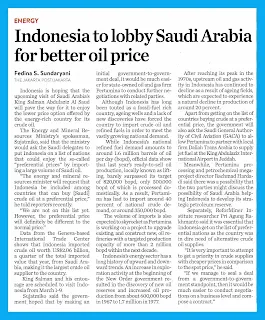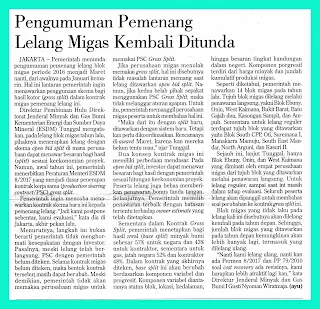Reforming Management of Mines in order to Bless Regions
Such areas need to touch mine fundamental reform. For the benefit of local communities and the glue of the nation, needs to go back to the constitution. The following notes.
WHEN Freeport quarrel with the central government in Jakarta, the Government of the affected area first punch. Mimika, the location of the giant mine, shaking. Most of the 34,000 employees of the mine is a demonstration to the Mimika DPRD.
They demanded the central government to compromise with Freeport, especially about the export permit concentrates. To save them from the fate of subsequent layoffs. Mimika regency government could also shake. A total of Rp 2 trillion from Rp 3 trillion budget District Government in this Aru Sea coast from Freeport. While revenue from Freeport Papua provincial government called the Governor Lukas Enembe only Rp 200 billion per year. However, the impact of layoffs is very hard for Papua.
Minister of Energy and Mineral Resources (ESDM) Ignatius Jonan himself called Freeport is not an elephant, but a cow. The deposit only Rp 8 trillion per year (Rp 214 trillion over 25 years). Excise revenue of Rp 149.5 trillion cigarettes a year (2015). For the central government, Freeport could be considered great. However, reliance Mimika and Papua to Freeport needs to be mitigated. It is also an indication that the high reliance on "easy money" from its Grasberg mine turned out to be fragile.
Since February 12, PT Freeport Indonesia could not continue because of blocked exports of Energy and Mineral Resources Regulation 6/2016, a derivative of the Government Regulation 1/2017 In essence, the export license can be granted, with the provision of business license Contract of Work (COW) turned into Special Mining Business License (IUPK). Freeport challenging to lay off employees and threatened to take to the international arbitration.
However, the money that comes from the Freeport mine deemed not to bring the welfare of local people. Not only there alone. Kutai Regency, East Kalimantan, to obtain funds for the results (DBH) of oil and gas are very large, but poverty remains very real. In a note NGO Publish What You Pay (PWYP) calls, the district has a population of 2016 budget 717 thousand inhabitants was obtained DBH Rp 3.8 trillion. Last year's Rp 4.8 trillion. However, the recipient Rice for Poor families reach 5,027 heads of household, or 26.52 percent of all recipients rice for poor families in East Kalimantan.
In East Java region rich with oil and gas, but also familiar with poverty and human development index (HDI) is left is the island of Madura. "Arguably, Madura Island sitting on oil and gas fields," said Dr. Sutikno, FE lecturers Trunojoyo University, in the discussions at the FEB Universitas Brawijaya (22/2). Discussions had the theme "Oil and Gas for the People?"
Sutikno describes the distribution of oil and gas in Madura. In Bangkalan and Sampang existing production (exploitation). The most numerous in Sumenep regency. Three of them have entered the stage of exploitation (already produced). Namely, the block Pagerungan, Maleo block, and a block of Madura Strait. Five other companies that operate in Sumenep already in the process of exploration. "All the activities that operate at sea. Only EML operating on the mainland, which is in District Saronggi," said Sutikno.
With the abundant oil wealth, 60 percent Sumenep a supplier of gas in East Java. Through a subsea pipeline, 350 km, Sumenep gas flowed into the industrial area of East Java, such as Sidoarjo, Surabaya and Gresik. Oil and gas potential in Sumenep, according to data from the Ministry of Energy, was 6 trillion cubic feet and can be sucked up to 30 years.
Actually, the Government of Sumenep already won a judicial review of the Minister of Home Affairs put the block Maleo so ration provinces in MA in 2008. Block Maleo inserted after remeasured Sumenep ration of coastline. Supposedly, the result of oil and gas can be 12 per cent, 6 per cent of the province and districts / cities in East Java 12 percent. However, DBH its reference to the provincial quota share Sumenep 10 percent and 20 percent with 37 districts / cities in East Java.
Oil and gas in order to bring prosperity blessing, Sutikno looking at oil and gas management should not be run by the private sector, especially by foreigners. "Because the same as letting capitalistic policies, namely the liberalization of the oil and gas, both in the downstream sector including price policy as well as in the upstream sector which will determine the amount of oil and gas production,".
Accelerated poverty reduction, economic growth driven BPS recorded Bojonegoro economy grew 13.37 percent (5.8 percent excluding oil and gas). HDI rose from 65.27 percent to 66.17 percent. The villages triggered build, according to economic activities. For example, do paving work on the streets, instead of paving, because the villagers can produce paving. However, there is anxiety.
"The success because commitments Bojonegoro Regent Suyoto. If you change the regent in 2018, what is still hope the funds entered the village?" asked Prof Munawar Ismail in the discussion.
IN INDONESIAN
Mereformasi Pengelolaan Tambang agar Memberkahi Daerah
Duduk di Ladang Migas, Tidak Juga Kaya
Daerah-daerah penghasil tambang perlu sentuhan reformasi mendasar. Agar bermanfaat bagi masyarakat sekitar dan menjadi perekat bangsa, perlu kembali ke konstitusi. Berikut catatannya.
PADA saat Freeport bergaduh dengan pemerintah pusat Jakarta, Pemerintah daerah yang terkena pukulan pertama. Mimika, lokasi tambang raksasa itu, guncang. Sebagian dari 34.000 karyawan tambang tersebut demo ke kantor DPRD Mimika.
Mereka menuntut Pemerintah Pusat berkompromi dengan Freeport, terutama soal izin ekspor konsentrat. Demi menyelamatkan nasib mereka dari PHK susulan. Pemerintah Kabupaten Mimika juga bisa guncang. Sebanyak Rp 2 triliun dari Rp 3 triliun APBD Pemerintah Kabupaten di pantai Laut Aru ini dari Freeport. Sedangkan pendapatan Pemerintah Provinsi Papua dari Freeport disebut Gubernur Lukas Enembe hanya Rp 200 miliar per tahun. Namun, dampak PHK sangat berat bagi Papua.
Menteri Energi dan Sumber Daya Mineral (ESDM) Ignasius Jonan sendiri menyebut Freeport bukan gajah, tapi sapi. Setorannya cuma Rp 8 triliun per tahun (Rp 214 triliun selama 25 tahun). Pendapatan Cukai rokok saja Rp 149,5 triliun setahun (2015). Bagi Pemerintah pusat, Freeport bisa saja dianggap tidak besar. Tapi, ketergantugan Mimika dan Papua kepada Freeport perlu dimitigasi. Ini juga menunjukkan indikasi bahwa ketergantungan tinggi pada "duit mudah” dari tambang Grasberg ternyata bisa rapuh.
Sejak 12 Februari lalu, PT Freeport Indonesia tidak bisa melanjutkan ekspor karena terhalang Peraturan Menteri ESDM 6/ 2016, turunan dari Peraturan Pemerintah 1/ 2017. Intinya, izin ekspor bisa diberikan, syaratnya izin usaha Kontrak Karya (KK) berubah menjadi Izin Usaha Pertambangan Khusus (IUPK). Freeport menantang dengan mem-PHK karyawan dan mengancam membawa ke arbitrase internasional.
Bagaimanapun, duit yang datang dari tambang Freeport dianggap belum membawa kesejahteraan warga sekitar. Tidak hanya di sana saja. Kabupaten Kutai Kartanegara, Kalimantan Timur, memperoleh dana bagi hasil (DBH) migas yang sangat besar, tetapi kemiskinan tetap sangat nyata.
Dalam catatan NGO Publish What You Pay (PWYP) menyebut, APBD 2016 kabupaten berpenduduk 717 ribu jiwa itu memperoleh DBH Rp 3,8 triliun. Tahun sebelumnya Rp 4,8 triliun. Tetapi, penerima Beras untuk keluarga Miskin mencapai 5.027 Kepala Keluarga atau 26,52 persen dari seluruh penerima Beras untuk keluarga Miskin di Kalimantan Timur.
Wilayah di Jawa Timur yang kaya dengan minyak dan gas, tapi juga akrab dengan kemiskinan dan indeks pembangunan manusia (IPM) tertinggal adalah Pulau Madura. "Boleh dikatakan, Pulau Madura duduk di atas ladang minyak dan gas," kata Dr Sutikno, dosen FE Universitas Trunojoyo, dalam diskusi di FEB Universitas Brawijaya (22/2). Diskusi itu bertema "Migas untuk Rakyat?"
Sutikno memaparkan sebaran minyak dan gas di Madura. Di Bangkalan dan Sampang sudah ada yang berproduksi (eksploitasi). Yang paling banyak di Kabupaten Sumenep. Tiga di antaranya telah masuk tahap eksploitasi (sudah menghasilkan). Yakni, blok Pagerungan, blok Maleo, dan blok Madura Strait. Lima perusahaan lainnya yang beroperasi di Sumenep sudah masuk dalam proses eksplorasi. "Semua kegiatan itu beroperasi di laut. Hanya EML yang beroperasi di daratan, yakni di Kecamatan Saronggi," kata Sutikno.
Dengan kekayaan migas melimpah itu, Sumenep menjadi penyuplai 60 persen gas Jawa Timur. Melalui pipa bawah laut, sepanjang 350 km, gas Sumenep dialirkan ke kawasan industri Jawa Timur, seperti Sidoarjo, Surabaya, dan Gresik. Potensi migas di Sumenep, menurut data Kementerian ESDM, masih 6 triliun kaki kubik dan bisa disedot hingga 30 tahun mendatang.
Sebenarnya, Pemerintah Kabupaten Sumenep sudah memenangkan uji materiil Peraturan Menteri Dalam Negeri yang menempatkan blok Maleo jadi jatah provinsi di MA pada 2008. Blok Maleo dimasukkan jatah Sumenep setelah diukur ulang dari garis pantainya.
Semestinya, bagi hasil migasnya dapat 12 persen, provinsi 6 persen, dan kabupaten/kota lain di Jatim 12 persen. Namun, DBH-nya mengacu pada jatah provinsi 10 persen dan Sumenep berbagi 20 persen dengan 37 kabupaten/kota di Jatim.
Agar berkah migas membawa kemakmuran, Sutikno memandang pengelolaan migas tidak boleh dijalankan oleh swasta, apalagi oleh pihak asing. "Karena sama halnya dengan membiarkan kebijakan kapitalistik, yakni liberalisasi migas, baik di sektor hilir termasuk kebijakan harganya maupun di sektor hulu yang sangat menentukan jumlah produksi migas,”.
Daerah juga perlu berbenah. NGO PWYP merujuk Bojonegoro sebagai pengelola migas yang berhasil. Bupati Suyoto memberlakukan Petroleum Fund (semacam dana abadi) sejak 2014. Pada 2015, DBH Bojonegoro sebagai kabupaten penghasil Rp 1,4 triliun. Sebagian digunakan untuk membeli 10 persen saham Bank Jatim.
Pengentasan kemiskinan dipercepat, ekonomi didorong tumbuh BPS mencatat ekonomi Bojonegoro tumbuh 13,37 persen (5,8 persen tanpa migas). IPM naik dari 65,27 persen ke 66,17 persen. Desa-desa dipicu membangun, sesuai dengan kegiatan ekonominya. Misalnya, dilakukan pekerjaan paving dijalanan, bukan pengaspalan, karena orang desa bisa memproduksi paving. Namun, masih ada kecemasan.
"Keberhasilan Bojonegoro karena ada komitmen Bupati Suyoto. Kalau ganti bupati tahun 2018, apa masih ada harapan dana masuk sampai ke seluruh desa?" tanya Prof Munawar Ismail dalam diskusi tersebut.
Jawa Pos, Page-2, Tuesday, Feb, 28, 2017









